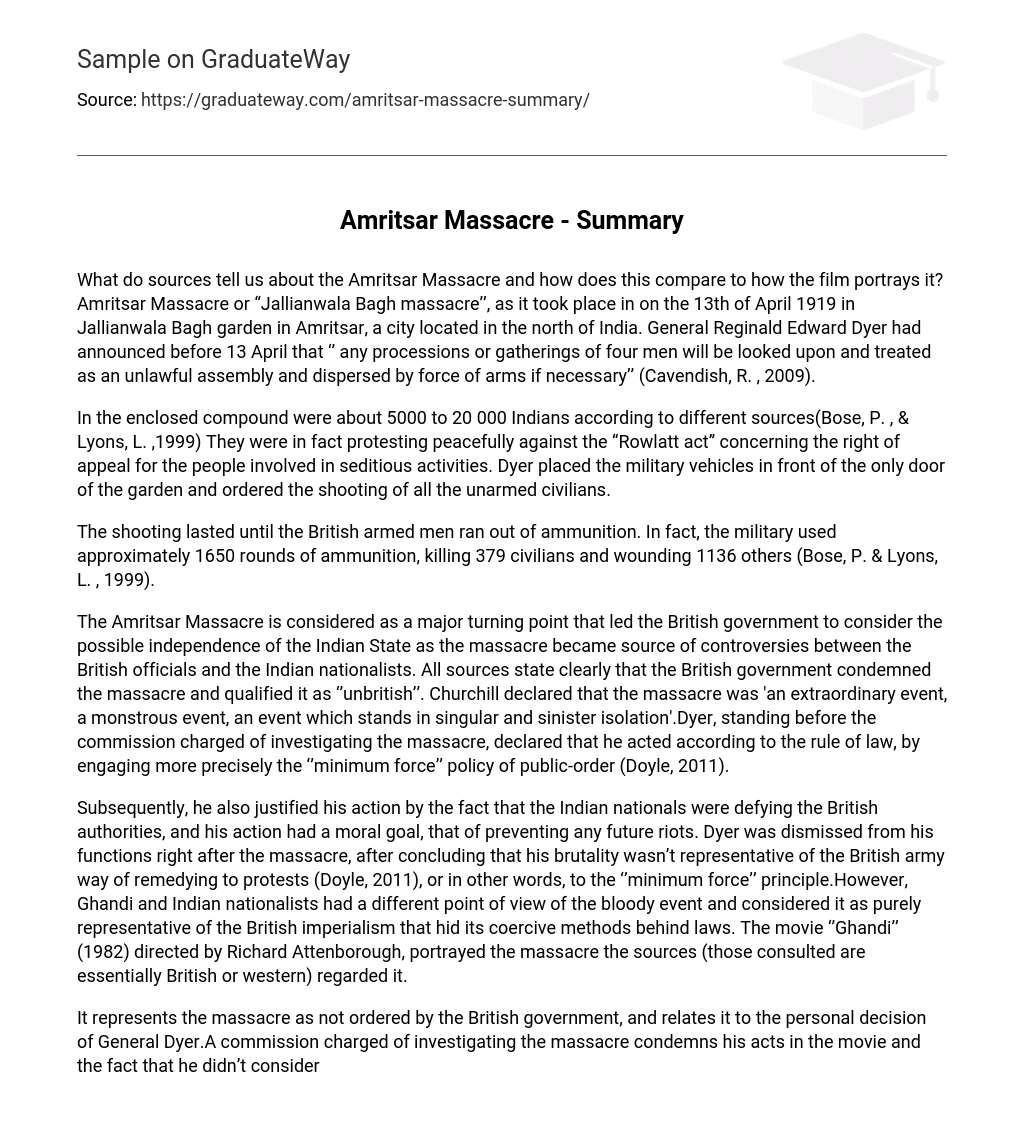What do sources tell us about the Amritsar Massacre and how does this compare to how the film portrays it? Amritsar Massacre or “Jallianwala Bagh massacre’’, as it took place in on the 13th of April 1919 in Jallianwala Bagh garden in Amritsar, a city located in the north of India. General Reginald Edward Dyer had announced before 13 April that ‘’ any processions or gatherings of four men will be looked upon and treated as an unlawful assembly and dispersed by force of arms if necessary’’ (Cavendish, R. , 2009).
In the enclosed compound were about 5000 to 20 000 Indians according to different sources(Bose, P. , & Lyons, L. ,1999) They were in fact protesting peacefully against the “Rowlatt act” concerning the right of appeal for the people involved in seditious activities. Dyer placed the military vehicles in front of the only door of the garden and ordered the shooting of all the unarmed civilians.
The shooting lasted until the British armed men ran out of ammunition. In fact, the military used approximately 1650 rounds of ammunition, killing 379 civilians and wounding 1136 others (Bose, P. & Lyons, L. , 1999).
The Amritsar Massacre is considered as a major turning point that led the British government to consider the possible independence of the Indian State as the massacre became source of controversies between the British officials and the Indian nationalists. All sources state clearly that the British government condemned the massacre and qualified it as ‘’unbritish’’. Churchill declared that the massacre was ‘an extraordinary event, a monstrous event, an event which stands in singular and sinister isolation’.Dyer, standing before the commission charged of investigating the massacre, declared that he acted according to the rule of law, by engaging more precisely the ‘’minimum force’’ policy of public-order (Doyle, 2011).
Subsequently, he also justified his action by the fact that the Indian nationals were defying the British authorities, and his action had a moral goal, that of preventing any future riots. Dyer was dismissed from his functions right after the massacre, after concluding that his brutality wasn’t representative of the British army way of remedying to protests (Doyle, 2011), or in other words, to the ‘’minimum force’’ principle.However, Ghandi and Indian nationalists had a different point of view of the bloody event and considered it as purely representative of the British imperialism that hid its coercive methods behind laws. The movie ‘’Ghandi’’ (1982) directed by Richard Attenborough, portrayed the massacre the sources (those consulted are essentially British or western) regarded it.
It represents the massacre as not ordered by the British government, and relates it to the personal decision of General Dyer.A commission charged of investigating the massacre condemns his acts in the movie and the fact that he didn’t consider the presence of women and children in the crowd is also clearly highlighted. Moreover, during a conference that Ghandi attended, the massacre is said to be fully condemned by British population and the government, but Ghandi’s point of view isn’t evoked, except a scene where he is desolated in front of the scenery showing the victim’s blood left in the compound after the massacre.Both the sources and the movie state that the British government had no responsibility of the massacre, since it was carried out by Dyer without direct from his superiors, and thus concluding that his violent action is not representative of the British government.
Two biographies were written about General Dyer, and they both clearly associate the massacre to his troubled temperament and to his personal life (Lloyd, 2007), which according to me removes any responsibility from the British army.It is important to note that Britain didn’t apologize for the massacre since its occurrence in 1919. Sources: * Cavendish, R. (2009, April).
The Amritsar massacre. History Today, 59(4), 13. * Doyle, M. (2011).
Massacre by the book: Amritsar and the rules of public-order policing in Britain and India. . Britain & the World, 4(2), 247-268. * Bose, P.
, & Lyons, L. (1999). Dyer consequences: The trope of Amritsar, Ireland, and the lessons of the `minimum. Boundary 2, 26(2), 199.
* Lloyd, N. (2007). The butcher of Amritsar: General Reginald Dyer. .
War in History, 14(1), 118-120.





